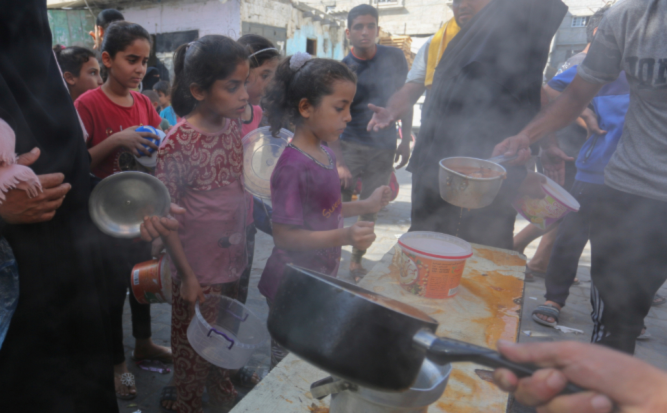All of Gaza faces 'crisis or worse' hunger level: UN
According to a UN IPC report, by February 7, half of the population will be in the "emergency" phase, which includes severe acute malnutrition and excess mortality.
-

Palestinian children receive food in Rafah south Gaza on November 8, 2023. (AP)
According to the UN's hunger monitoring system on Thursday, every citizen in the besieged Gaza Strip will confront high levels of acute food insecurity over the next six weeks.
The Integrated Food Security Phase Classification (IPC), a five-scale food insecurity categorization, predicted in its "most likely scenario" that by February 7, "the entire population in the Gaza Strip (about 2.2 besieged people)" will be suffering from "crisis or worse" hunger.
"This is the highest share of people facing high levels of acute food insecurity that the IPC initiative has ever classified for any given area or country," the IPC stated.
Concerns are on the rise over Gazans who are subjected to daily bombing, food and water shortages, and mass displacement.
According to the report, by February 7, half of the population will be in the "emergency" phase, which includes severe acute malnutrition and excess mortality.
"Even though the levels of acute malnutrition and non-trauma related mortality might not have yet crossed famine thresholds, these are typically the outcomes of prolonged and extreme food consumption gaps."
International humanitarian organization CARE called the figures "alarming".
The Euro-Med Human Rights Monitor published a new study on Tuesday, revealing distressing levels of starvation in the Palestinian Gaza Strip.
The study revealed that 71% of the Gaza population is grappling with acute hunger, while 98% is dealing with insufficient food intake. Additionally, 64% have turned to eating fruits, wild or raw food, and expired items as a means of alleviating hunger.
🚨 Alarming figures from @EuroMedHR study on hunger levels in Gaza set to be released tomorrow:
— Ramy Abdu| رامي عبده (@RamAbdu) December 18, 2023
71% of Gaza's population faces severe hunger, with 98% experiencing inadequate food consumption. 64% resort to consuming fruits, wild or
raw food, & expired items to alleviate hunger. pic.twitter.com/KWZ5niYo7j
The study also highlighted that the daily water access rate for individuals in the Gaza Strip, encompassing drinking, bathing, and cleaning water, stands at 1.5 liters per person. This falls short by 15 liters compared to the essential water requirements for survival as per international SPHERE standards. The research also delved into the consequences of malnutrition and the absence of access to safe drinking water. Sixty-six percent of the participants in the study disclosed instances or a history of gastrointestinal diseases, diarrhea, and skin rashes during the current month.
Since the onset of the genocidal war on Gaza, "Israel" has imposed a comprehensive blockade on the territory, preventing the supply of food, water, fuel, and other humanitarian needs to more than 2.3 million people. Subsequently, the Israeli strategy of siege intensified, cutting off all food supplies and bombing and destroying bakeries, factories, food stores, and water stations.
'Israel' using starvation of civilians as warfare method in Gaza: HRW
In a related development, Human Rights Watch (HRW) said "Israel" is intentionally hindering the supply of food and water in the Gaza Strip and using starvation of civilians as a method of warfare.
"Israeli forces are deliberately blocking the delivery of water, food, and fuel, while willfully impeding humanitarian assistance, apparently razing agricultural areas, and depriving the civilian population of objects indispensable to their survival … The Israeli government is using starvation of civilians as a method of warfare in the Gaza Strip, which is a war crime," the human rights group said in a statement.
HRW urged the Israeli occupation government to lift a blockade of the Strip and called on the United States, the United Kingdom, Canada, Germany, and other states to suspend any military aid to "Israel".

 3 Min Read
3 Min Read








